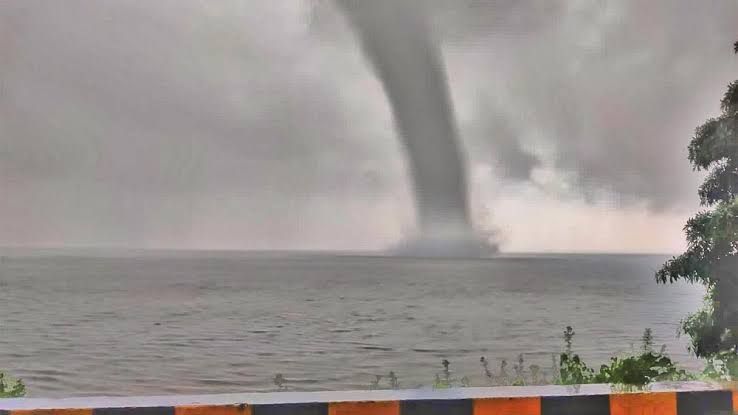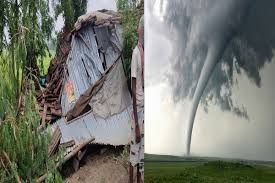A tornado is a violently rotating column of air that is in contact with both the surface of the Earth and a cumulonimbus cloud or, in rare cases, the base of a cumulus cloud. It is often referred to as a twister, whirlwind or cyclone,[1] although the word cyclone is used in meteorology to name a weather system with a low-pressure area in the center around which, from an observer looking down toward the surface of the Earth, winds blow counterclockwise in the Northern Hemisphere and clockwise in the Southern.[2] Tornadoes come in many shapes and sizes, and they are often visible in the form of a condensation funnel originating from the base of a cumulonimbus cloud, with a cloud of rotating debris and dust beneath it. Most tornadoes have wind speeds less than 180 km/h (110 mph), are about 80 m (250 feet) across, and travel several kilometers (a few miles) before dissipating. The most extreme tornadoes can attain wind speeds of more than 480 km/h (300 mph), are more than 3 km (2 miles) in diameter, and stay on the ground for more than 100 km (dozens of miles).

Season
Primarily spring and summer, but can be at any time of year
Effect
Wind damage

Various types of tornadoes include the multiple vortex tornado, landspout, and waterspout. Waterspouts are characterized by a spiraling funnel-shaped wind current, connecting to a large cumulus or cumulonimbus cloud. They are generally classified as non-supercellular tornadoes that develop over bodies of water, but there is disagreement over whether to classify them as true tornadoes. These spiraling columns of air frequently develop in tropical areas close to the equator and are less common at high latitudes.[6] Other tornado-like phenomena that exist in nature include the gustnado, dust devil, fire whirl, and steam devil.

Tornadoes occur most frequently in North America (particularly in central and southeastern regions of the United States colloquially known as Tornado Alley; the US and Canada have by far the most tornadoes of any countries in the world).[7] Tornados also occur in South Africa, much of Europe (except Spain, most of the Alps, Balkans, and northern Scandinavia), western and eastern Australia, New Zealand, Bangladesh and adjacent eastern India, Japan, Philippines, and southeastern South America (Uruguay and Argentina).[8][9] Tornadoes can be detected before or as they occur through the use of pulse-Doppler radar by recognizing patterns in velocity and reflectivity data, such as hook echoes or debris balls, as well as through the efforts of storm spotters.